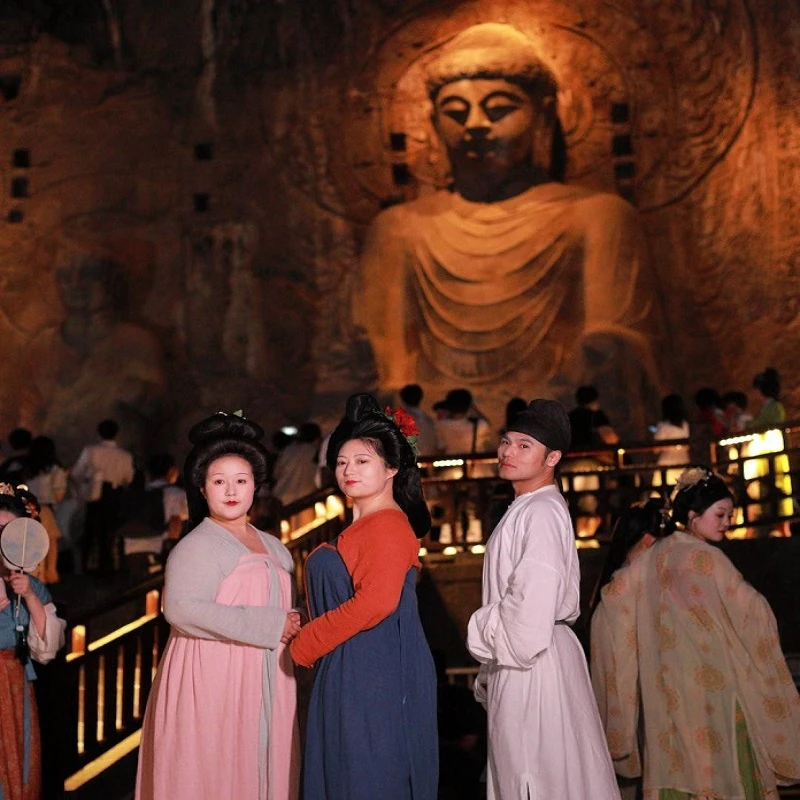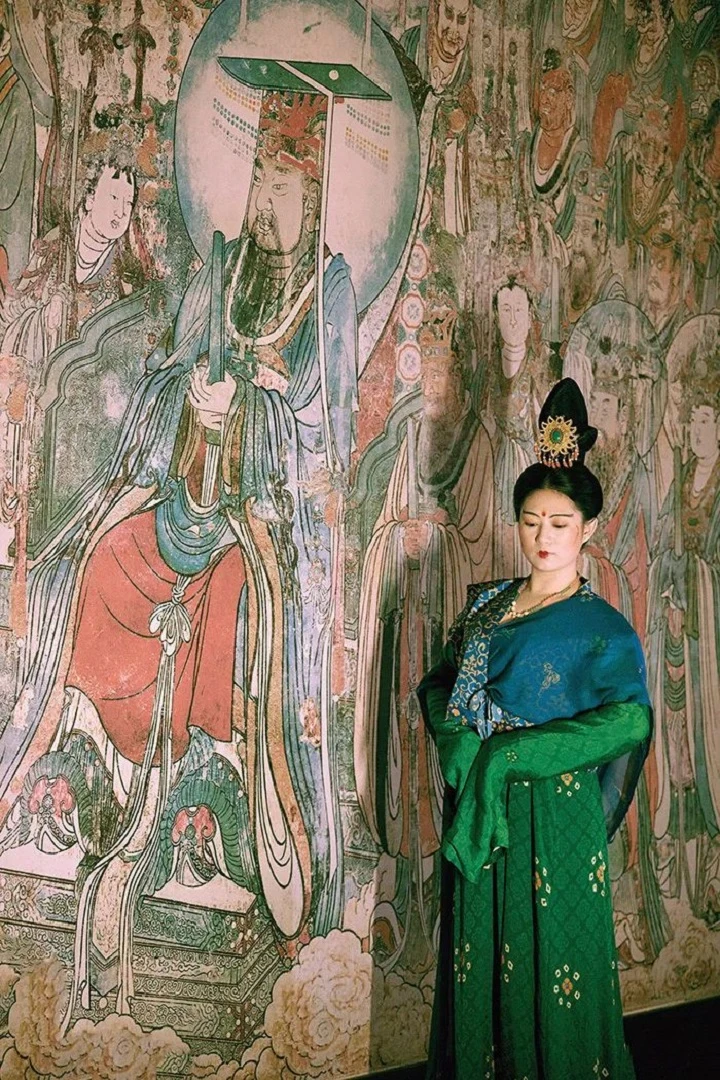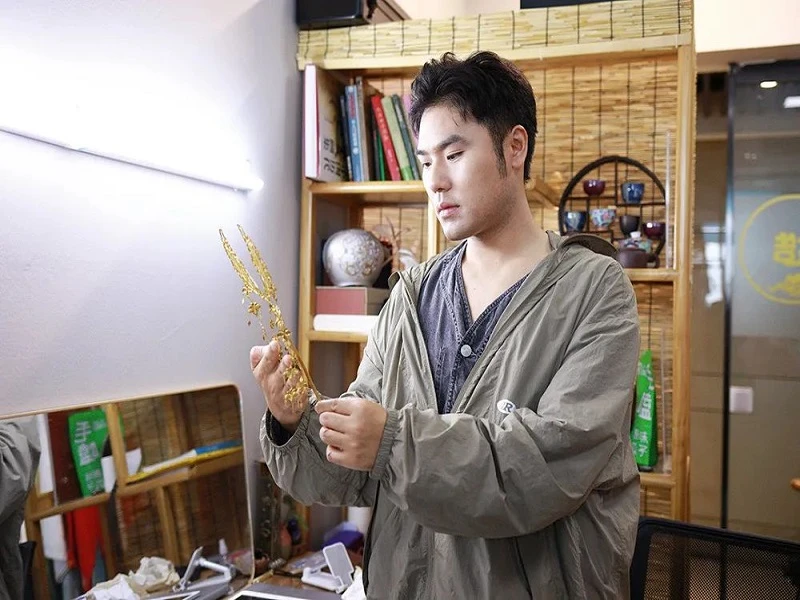In the heart of Luoyang, a city steeped in ancient Chinese culture, lies a revival movement that's reshaping how people perceive traditional attire. Here, amidst the bustling streets and ancient monuments, the art of Tang Dynasty attire, or Hanfu, is experiencing a renaissance that goes beyond mere fashion—it's a cultural statement.
The Late Tang Experience
My unexpected journey into the world of Late Tang fashion began innocuously enough in Luoyang's Justice Street (正义街) , at the "Buwan Guofeng Studio (不晚国风工作室)". Here, I met Nanjie, a restoration stylist, and her apprentice Pinglan. What started as a simple interview quickly transformed into an immersive experience as they recreated a Late Tang ensemble on me.
Drawing inspiration from popular Tang Dynasty patterns and makeup styles seen in Dunhuang murals, they meticulously adorned me with the iconic elements: a towering hair bun adorned with floral hairpins, delicately arched eyebrows, intricate forehead ornaments, and a cherry blossom-like smile. The ensemble was completed with a chest-high ruqun adorned with classic Tang motifs—a stark contrast to my worn-out Converse sneakers from Beijing.
Once dressed, I, along with the photographer, Nanjie, and Pinglan, embarked on a stroll down Justice Street. In Luoyang, much like in Xi'an, the entire city serves as a backdrop for Hanfu photoshoots. Women in billowing skirts zip around on electric scooters during the day, while evenings see them dining on lamb hotpot in the lanes behind Jiuzhou Pond—scenes that no longer surprise the locals. Even at hotel receptions, questions like "How much did this restoration cost?" reflect a growing appreciation.
However, my attire still managed to draw extra attention. Nanjie attributed this to the common sight of what many perceive as Hanfu—often "immortal clothing" characterized by flowing skirts and ethereal hair—which actually do not conform to any Tang or Song Dynasty era. Modern makeup trends like false eyelashes and heavy eyeliner are also entirely absent from Tang-era styles. In contrast, this elaborate Late Tang Dunhuang restoration stands out, starkly different from the usual Hanfu attire.
The Cultural Conundrum of Restoration
The journey through Luoyang’s streets, adorned in my recreated Tang Dynasty attire, was not without its challenges. Amidst the admiring glances, there were occasional moments of cultural misunderstanding. In a local bubble tea shop, a mother and daughter couldn't help but stare at me. The mother complimented, "So beautiful, almost Japanese-like." Of course, her intentions were innocent, but Nanjie quickly corrected her, "This is Hanfu." Reflecting on this encounter later, Nanjie remarked how enthusiasts of restoration often face such misconceptions—either being mistaken for Japanese or Korean.
These instances underscore a broader issue faced by enthusiasts who venture out in such attire—misinterpretations are common, ranging from mistaken identities for Japanese kimono to Korean traditional clothing. It's a challenge that Hanfu designer Bao Yifan (包意凡) is all too familiar with. Bao, who previously filmed a video showcasing Tang Dynasty attire similar to mine at the Longmen Grottoes, was once mistaken by local students for wearing a kimono. He intervened humorously, "This is Hanfu! You should visit more museums."
This incident, captured and shared on his social media platforms, sparked a lively debate. It encapsulates the dilemma facing Tang Dynasty Hanfu enthusiasts—striving for authenticity amidst widespread misconceptions perpetuated by popular media and entertainment.
Nevertheless, several Hanfu studios are shifting towards restoration, with a noticeable increase in enthusiasts eager to experience Tang-era attire firsthand. In Luoyang, Bao Yifan stands as a prominent figure in this movement, skilled in designing, tailoring, and replicating Hanfu based on thorough research of archaeological finds.
The Co-Creative Hub
Donning a round-collared robe and a stubble beard, Bao Yifan resembles a flourishing figure from the heyday of the Tang Dynasty. Originally from Anyang, Henan, after university, Bao Yifan initially ventured to Hangzhou but eventually returned to his hometown—a common trajectory for many young Chinese returning to their roots.
Initially uncertain of his path back home, Bao Yifan's love for manga and comics became a pivotal hobby. Despite early attempts at traditional Chinese painting and sketching, his heart remained with manga. It wasn't until 2019, during an anime exhibition in Anyang, that Bao Yifan bought his first Hanfu—a smoke-colored Daoist robe with a cloak. Not content with just purchasing, he attempted his hand at making one, even though he lacked proper knowledge of the style, resulting in a rudimentary collared robe inspired by theatrical costumes.
As I continued my exploration in Luoyang, I found myself drawn deeper into the world of Tang Dynasty fashion revival. Every corner seemed to reveal a new facet of this cultural phenomenon, where enthusiasts and professionals alike worked tirelessly to resurrect the elegance of ancient attire.
The landscape is gradually shifting, with an increasing number of studios specializing in historical restorations. In Luoyang, Bao Yifan stands out as a prominent figure in this movement. Armed with deep knowledge of Tang Dynasty fashion and a meticulous eye for detail, Bao has amassed a collection of over twenty headpieces and created more than a hundred Tang Dynasty garments. His commitment to authenticity is evident in his designs, each piece meticulously crafted to replicate historical accuracy.
Cultural Resonance and Public Engagement
The impact of these efforts extends beyond mere fashion revival—it's a cultural renaissance that resonates with the public. During Luoyang's annual Peony Festival in 2022, organizers enlisted Bao Yifan to outfit NPCs for a historical drama titled "Observing Tang". The collaboration was a resounding success, leading to further invitations for Bao, including a special Hanfu fashion show at Luoyang's Yingtian Gate in 2023. Prepared meticulously over nearly a year, the show featured thirteen sets of restored Tang Dynasty attire spanning different periods from early Tang to late Tang.
Bao's journey from an enthusiast tinkering with Hanfu in his hometown of Anyang to a celebrated designer in Luoyang reflects a personal evolution intertwined with a broader cultural resurgence. His decision to leave a stable job and relocate underscores the growing significance of Tang Dynasty restoration in modern cultural discourse. For Bao, the journey has been more than just a career shift—it's a testament to his passion and dedication to preserving and promoting Tang Dynasty heritage.
Navigating Modernity and Tradition
Despite these achievements, challenges remain in bridging the gap between tradition and modern sensibilities. As I observed during my time in Luoyang, the intersection of Tang Dynasty fashion with contemporary life often sparks curiosity and admiration but also invites skepticism and misunderstanding. The journey of Tang Dynasty restorationists like Bao Yifan is not just about creating beautiful garments; it's about challenging perceptions, educating the public, and ensuring that the legacy of Tang Dynasty fashion endures.
In conclusion, my journey as a "Late Tang Dynasty Noblewoman" in Luoyang allowed me to witness firsthand the complexities of Hanfu's revival. From the meticulous craftsmanship of restoration studios to the cultural resonance in public spaces, Luoyang exemplifies a city where ancient traditions are not merely preserved but celebrated with fervor. As Tang Dynasty fashion continues to captivate hearts and minds, it serves as a poignant reminder of the enduring power of cultural heritage in a rapidly evolving world.




